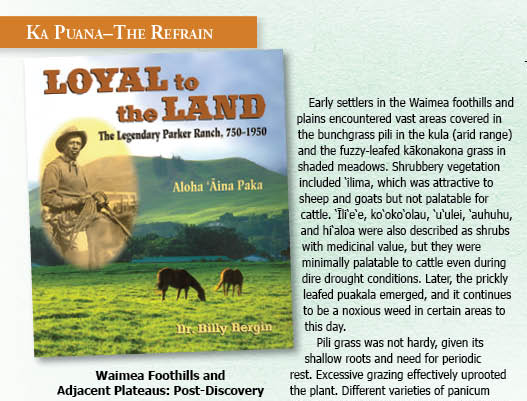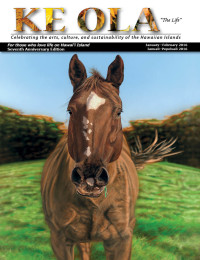
Loyal to the Land: The Legendary Parker Ranch, 750-1950
 Waimea Foothills and Adjacent Plateaus: Post-Discovery
Waimea Foothills and Adjacent Plateaus: Post-Discovery
In Exalted Sits the Chief, Ross Cordy maintains that early recorded post-discovery history describes the plateau of Waimea as being forested with ‘ōhi‘a lehua (Metrosideros collina). ‘Ala ‘Ōhi‘a (fragrance of ‘ōhi‘a) was the euphonious name given to the district. Reverend Lorenzo Lyons frequently described his home as ‘Ala ‘Ōhi‘a Nei (home of the fragrant ‘ōhi‘a lehua). Between the overwhelming impact of cattle herds, coupled with drought and the Great Fire of 1918, the district of Waimea is known today more for its rolling hills and plains covered with a variety of grasses and shrubs and a minimum of trees. Not only were the ‘ōhi‘a forests lost, but the koa, koai‘a, māmane, naio, and a host of other trees as well.

The rain forests of the Kohala Mountains also had abundant ‘ōhi‘a lehua trees. Despite alien species invasion, these stands remain today. Herbs, ferns, and mosses coexist in cooperative harmony, providing luxurious shade in the enduring undergrowth. These tropical jungles offer protection for the proliferation of humus, or pulu, that was significant for its water- and nutrient-retaining ability derived from decomposed vegetation. In exchange for shade, the pulu encircles the base of the tree, conserving additional moisture and nutrition. The early deforestation caused a decrease in rainfall and a reduced flow in streams, including the Waiaka, Kohakōhau, Waikoloa, Lanimaomao, and Keanu‘i‘omanō Streams.
Early settlers in the Waimea foothills and plains encountered vast areas covered in the bunchgrass pili in the kula (arid range) and the fuzzy-leafed kākonakona grass in shaded meadows. Shrubbery vegetation included ‘ilima, which was attractive to sheep and goats but not palatable for cattle. ‘Īli‘e‘e, ko‘oko‘olau, ‘u‘ulei, ‘auhuhu, and hi‘aloa were also described as shrubs with medicinal value, but they were minimally palatable to cattle even during dire drought conditions. Later, the prickly leafed puakala emerged, and it continues to be a noxious weed in certain areas to this day.
Pili grass was not hardy, given its shallow roots and need for periodic rest. Excessive grazing effectively uprooted the plant. Different varieties of panicum grass, especially kākonakona, were hardier. Other indigenous grasses found at more than 4,000-foot elevations drew the wild cattle to these mountain slopes. Notable among these are the heu pueo (owl fuzz), pili uka, and kalamālō, which were coarse but somewhat palatable. Pūkiawe (black-eyed Susan) was browsed only in times of drought, but crab grass (kūkae pua‘a), introduced earlier, was found to be succulent in the mountain meadows of Waimea.
In 1835, Bermuda grass, Cyanodon dactylon (mānienie) was introduced to Hawai‘i and was well suited to the lower elevation, drier plains and coastal ranges. This narrow-leafed perennial spreads both by seed and by sending out rootstocks that root at the joints along its stems. It is highly palatable, moderately nutritious, and drought resistant. Bermuda grass creates dense sod, which is highly effective in curbing the erosion of lighter coastal soils.
In 1840, Hilo grass (Paspalum conjugatum) came to the Islands. The town of Hilo has the dubious honor of being its first home. This hardy but relatively unpalatable grass covered the lower mid-elevation and wetter meadows of the ranch, especially on the windward side. Like mānienie, this grass spreads by means of seeds and runners sometimes extending for several yards, then rooting and sending out shoots from the nodes. While the rank Hilo grass possesses minimal nutritional value, it provided marginal feed for mature cattle, affording reproductive rates of moderate satisfaction. But breeding cattle could never fatten on Hilo grass, which was a well-known advantage of mānienie. Mānienie avoided the shaded base of the forest trees-even that of kiawe (algaroba or mesquite). Hilo grass in turn invaded the undergrowth of the mountain forests of native trees, ferns, and other delicate plants. The aggressive destruction of forest ground cover by Hilo grass coupled with the herds of wild cattle, fire, and drought actually contributed to the breakdown of the ecosystem and supplied only minimal nutritional value.
Contact author Dr. Billy Bergin
The three volumes of Loyal to the Land are available from Basically Books, Kona Stories, and other local bookstores.


